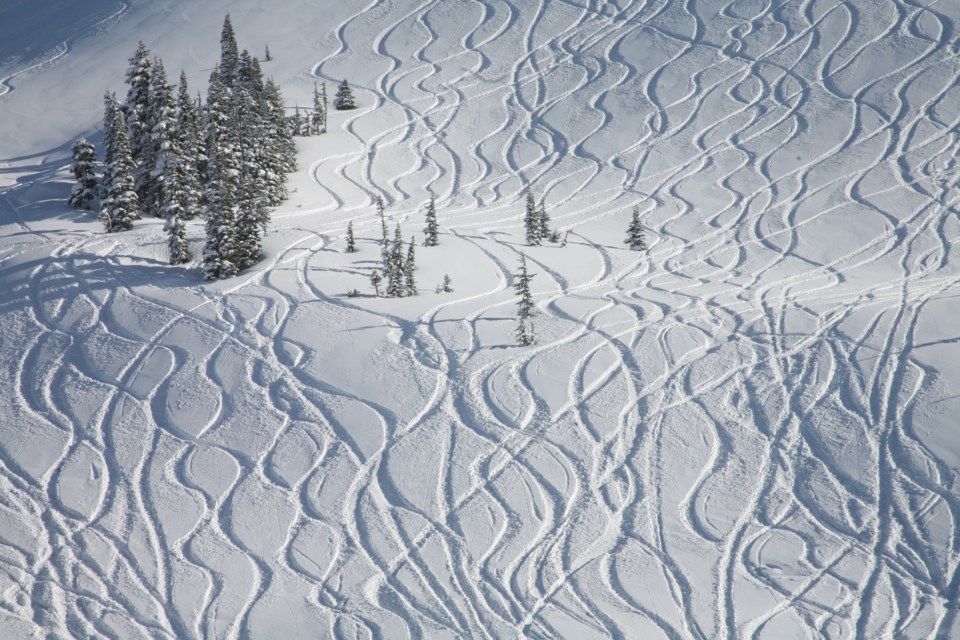The bad news? Whistler’s 2022-23 snow year wasn’t great. On the bright side? It was far from the worst winter on record.
According to Whistler Blackcomb’s snow and weather report for the last day of April, the resort received a total of 942 centimetres of snow to date this season. No more than a handful of centimetres of wet flurries are currently expected to fall before Blackcomb Mountain closes for skiing and snowboarding on May 22.
The resort's 2022-23 winter season kicked off with 119cm of snow in November and 202cm of snowfall in December, as listed on Tourism Whistler’s Weather History & Stats web page, before welcoming 174cm more in January, 142cm in February, 111cm in March, and 195cm last month. That means April was one of Whistler’s snowiest months of the season, second only to December.
Last season, Whistler welcomed a total of 1,139 cm of snow between the beginning of November and the end of May, according to Tourism Whistler.
The sub-950-cm season total is nowhere close to Whistler’s driest winter in the last 14 years. That title goes to the 2015-16 season, when only 672cm of snow fell between November and May. But this season's snow stats are even further from the snowiest winter recorded since 2008: that occurred immediately post-Olympics, in 2010-11, when a whopping 1,579cm fell.
Believe it or not, Whistler’s 2022-23 snowfall total also isn’t too far off from the 965cm that fell in 2019-20. However, with the record-breaking 477cm of snow that fell that January (plus the fact that the season came to an abrupt end in early March, ahead of what was a dry spring), we’d hazard a guess some locals still remember that winter fondly.
The difference this season? Whistler didn’t see a major dump of snow in one month, followed by a drought, like it has in other years. Instead, Mother Nature deposited the snow slowly and gradually over the last six months.
Experts had previously anticipated a ‘La Niña’ weather pattern to take hold across B.C.’s South Coast this winter. That prediction stems from cooler ocean-surface temperatures recorded in the Pacific, which usually correlate with colder temperatures and more precipitation falling over Coastal mountain ranges, though the pattern was expected to weaken as spring approached.
“If you looked at all the ‘La Niña’ years versus ‘El Niño’ years, you probably would see higher snowpacks,” Environment Canada meteorologist Trevor Smith told Pique back in February—but that forecast doesn’t guarantee a big snow year.
How much did you ski this year?
Forgive us for speculating, but there could be a chance the relatively low, spread-out tides had something to do with some locals spending fewer days on the slopes this winter.
After hearing from more and more locals in recent months who, for one reason or another, were not managing to record the same quantity of vertical as they usually would, Pique decided to find out once and for all: did Whistler regulars really spend less time on the slopes this winter?
Pique polled 300 online readers asking the question: “Skiers and snowboarders: how many days on snow have you had this winter?” The poll ran from April 14 to 21. Of the 300 votes, we can determine that 42 came from IP addresses within the community.
It turns out those anecdotal conversations do appear to have pointed towards a larger trend. Out of the 300 total votes, 51 per cent of total poll respondents reported spending fewer days on snow this winter than usual, compared to almost 24 per cent of readers who said they spent more time skiing or riding this winter, and 18 per cent of overall respondents who said they spent about the same time sliding downhill. Less than seven per cent of readers said they were out for the entire season, whether due to injury or another reason.
Meanwhile, a resounding 64 per cent of local respondents said they spent less time skiing or snowboarding this winter, compared to just 9.5 per cent of locals who got out on the slopes more often, and about 24 per cent of locals who tallied about the same number of days on snow. Just over two per cent of locals said they were out of commission for the season.




